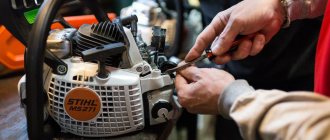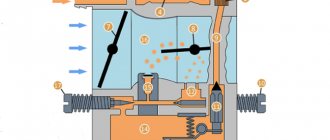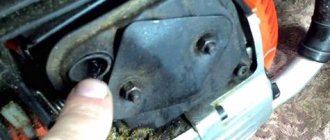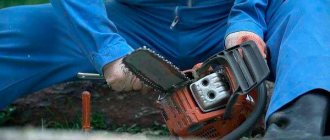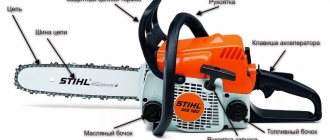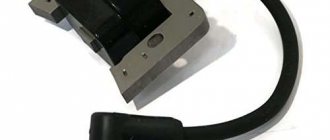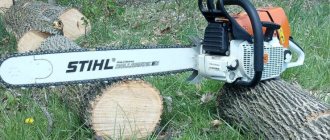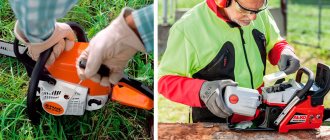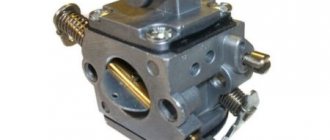Finding reasons why a chainsaw won't start
Amateur and professional chainsaws are complex devices. The motor life of their two-stroke engines, components and assemblies has its limitations. For this reason, quite reliable and expensive tools, along with cheap Chinese units, periodically fail and refuse to start. The situation when a chainsaw does not start or stalls is not very pleasant and sometimes confuses the user. How to identify and eliminate the malfunction, restoring the functionality of the tool.
There is a spark, the spark plug is wet
First of all, it is necessary to remove the muffler and carefully inspect the piston, since this is where the problem may be hidden. but the chainsaw still does not start or stalls, the saw does not start, Partner 350. In addition, most owners wonder: why does the chainsaw start and stall, while there are supposedly no problems with the spark plugs?
But this is an erroneous opinion and you don’t need to be so sure in this case, as there are situations when the candle sparks perfectly in air, but does not work directly in the cylinder.
The reason for this may be a direct violation of a kind of compaction in the canal area (impulsive). Or so there is a peculiar development of crankshaft oil seals, but this feature occurs in very rare cases.
The Shtil ms 660 chainsaw is the most economical of the entire Shtil chainsaw line. Its price ranges from 3,100 to 5,500 rubles.
Identifying and eliminating obvious chainsaw faults.
To determine the reason why the chainsaw does not start or stalls when starting, it is necessary to troubleshoot the tool. The essence of the procedure is a sequential inspection of the condition and operation of the main working elements of the saw engine. At this stage we check:
- Presence of a spark on the spark plug;
- Fuel supply;
- Filter status;
- Operation of the breather built into the fuel cap of the stalling unit;
- Functioning of the exhaust channel.
Checking the spark on the spark plug and eliminating the causes.
The first step in finding the reasons why a gasoline saw does not start is to check the spark on the spark plug. There are many factors that influence the operation of this element. However, the main ones at the initial stage of tool troubleshooting are:
- Incorrect carburetor adjustment;
- The presence of more than the required amount of oil in gasoline;
- Air filter clogged.
All of them contribute to the formation of carbon deposits on the spark plug electrodes. In 50 cases out of 100, saws do not start when cold due to the lack of a spark due to carbon deposits on the electrodes and their corrosion. The result is either a decrease in the gap or an increase in it.
Checking the spark plug of a non-working chainsaw
Checking for spark is quite simple. To do this you will need:
- Remove the tip of the high-voltage wire;
- Unscrew the spark plug;
- Put the tip back on;
- Place the candle skirt against the cylinder;
- Start with the starter.
If at the moment the chainsaw engine starts, a good spark is observed between the electrodes, then everything is in order with the ignition unit. If it is not there, then it is worth cleaning the element itself and checking the electrode gap. If necessary, use a special probe to adjust the distance between the contacts.
For spark plugs from different manufacturers, the distance between the electrodes may vary. For some it may be equal to 0.5 mm. Others have 0.2 mm. Therefore, carefully study the manufacturer's recommendations.
There may be no spark at the spark plug for other reasons. The main malfunctions that affect poor starting of the chainsaw and unstable operation of the internal combustion engine at idle, which can cause the tool to stall, include the following:
- Overfilling of the spark plug channel with fuel;
- Lack of contact between the high-voltage cradle and the tip of the spark plug;
- Failure of the ignition unit.
How to start a cold chainsaw if the spark plug channel is constantly flooded with gasoline? You can fix the problem while starting the tool using the following algorithm:
- Unscrew the spark plug with a special wrench;
- Wipe it with a clean and dry cloth;
- Dry for 20...30 minutes;
- Remove carbon deposits with a file and adjust the gap between the electrodes;
- Drain the remaining fuel from the spark plug channel and dry it;
- Collect everything and try to start the mechanism.
As a rule, these measures are quite enough to start the chainsaw and get the job done. However, this extreme measure does not eliminate the main reason why the engine does not start or stalls - improper operation of the carburetor, which needs fine adjustment.
If there is no spark due to poor contact of the high-voltage cradle with the tip of the spark plug, it is necessary to check the connection. The test can be carried out using a regular tester. If a defect is detected and corrected, the chainsaw should start without any problems.
If the check shows that the contact is reliable, but the saw still does not start, look for the reason in the ignition unit. As a rule, a faulty unit cannot be repaired or restored. This will require a complete replacement.
We determine the availability of fuel and its supply.
First, you need to make sure that there is a fuel mixture in the tank of the chainsaw that does not want to start, and that it is properly supplied to the carburetor. With a full tank, check how the mixture is supplied through the gas line. We disconnect the fuel system pipe from the carburetor and try to pump it up. In case of complete order, when pumping, gasoline will be supplied jerkily in accordance with the standards set by the manufacturer. Weak fuel supply or its absence can result from:
- The fuel supply channel is clogged;
- Fuel filter clogged with debris.
Often the cause of poor starting of a chainsaw can be a too full tank. In this case, you should pay attention to the presence of smudges under the saw housing cover. If they are present, then look at the connection of the gasoline supply pipe to the carburetor. Most often, it is squeezed out by pressure when screwing on the tank cap, which is tucked right under the neck, which prevents the engine from starting.
The quality of the fuel mixture can also be one of the reasons why the chainsaw does not start. If, after completing the work, you do not drain the remaining gasoline and leave the tool for long-term storage (more than 2 weeks), then the processes of resin formation and polymerization of the components will begin to occur inside the tank. What can cause carbon deposits to appear on the piston, rings and cylinder liner. Therefore, always prepare the mixture in only the required quantity before work.
Checking the condition of the fuel and air filters.
If the fuel quality is fine, the chainsaw engine may not start due to clogged fuel and air filters. To diagnose these elements, you will need to perform a number of manipulations associated with their dismantling.
For fuel filter:
- Disconnect the gasoline supply line from the carburetor;
- Pump up the fuel.
If there is little or no pressure in the pipe, disconnect the filter. Before doing this, empty the tank of the mixture and remove the filter element itself. Dismantling is done using a wire hook. A clogged replacement cartridge that causes poor starting of the chainsaw engine can be cleaned, but it is best to replace it with a new one. When using the tool in dusty conditions, cleaning should be done on a regular basis.
A clogged air filter can cause the chainsaw engine to run rough, causing it to stall or be difficult to start. Dust and dirt deposited on the adsorbent material make it difficult for air to enter the system, making the fuel mixture so rich that it will sometimes be difficult to start the tool.
Checking the air filter is one of the first steps in finding the causes of poor starting.
Removing the air filter should be done with caution, since dust accumulated on its surface during operation of the saw can get into the carburetor. And this is fraught with more expensive repairs. After disconnecting the cartridge, thoroughly clean it of accumulated dirt and wash it with detergent. Dry the element and carefully put it back in place.
Checking the breather and cleaning it.
The breather is another element, due to improper operation of which the chainsaw may not start or stall during the sawing process. This element is located on the fuel tank cap in the area of the air hole. This is a kind of valve that does not allow gasoline to leak out and equalizes the air pressure necessary for the free flow of fuel into the carburetor.
Checking the muffler
Most likely, the reason lies in the muffler, which is clogged with combustion products (deposits) or simply debris. It is enough to clean it, and normal operation of the chainsaw will be restored. To do this, it is best to dismantle this part and wash it using ordinary detergents (aggressive ones are possible). Then rinse the muffler thoroughly with clean water and dry it with a hairdryer.
Cleaning the muffler usually has a positive effect
When cleaning, be careful: carbon deposits contain carcinogenic substances that, if they enter the lungs, can be harmful to health. The reason for the appearance of carbon deposits is the incorrect ratio of gasoline and oil poured into the tank. Most users prefer to do this “by eye”. But maintaining the exact proportions is not at all difficult: just use a disposable syringe without a needle of the appropriate volume.
What to do if the chainsaw continues to not start?
If the initial inspection did not yield anything or the defects were eliminated during the search process, but the chainsaw still does not start, then you need to look for more serious reasons. It is best to identify and repair such breakdowns at a service center. However, if you have experience, you can find and eliminate them yourself. What to diagnose and check?
- Compression in the cylinder;
- Compression in the crankcase;
- Carburetor operation.
In the first case, checking the compression in the cylinder will allow you to find out the condition of the cylinder-piston group (CPG) of a chainsaw that does not want to start when cold. To do this you need a compression gauge. The device is screwed into place of the spark plug and the engine is started idle. Measuring the readings allows you to judge the condition of the CPG. In the absence of a compression gauge, you can determine the compression in the cylinder offhand as follows:
- Place your finger on the spark plug hole;
- Try to start the chainsaw engine.
By placing your finger on the spark plug hole and pulling the starter, you can check the compression in the cylinder
If you feel that your finger is being pulled strongly into the spark plug channel, then everything is in order with compression. The absence of vacuum in the chamber indicates a malfunction. The cylinder-piston group needs a more detailed inspection, which will give an idea of the condition of the piston and cylinder, piston rings and bearings.
A chainsaw may not start when cold due to a lack of compression in the engine crankcase. The main reason for this is damage to the gasket located between the cylinder and the crankcase. It is quite easy to detect a lack of compression:
- Disconnect the upper tube from the carburetor;
- Pour gasoline into a regular cork;
- We immerse the removed tube in the fuel;
- We pull the starter several times.
If fuel is sucked out of the cap when the chainsaw starter starts, then everything is fine with compression. If not, look at the gasket.
If the fuel is drawn in, then everything is fine - the gasket is intact. Otherwise, you will have to purchase a repair kit and make a replacement. How to do this, watch the video why a Chinese chainsaw won’t start:
Starting the tool may be complicated by improper operation of the carburetor or its breakdown. It often happens that during the sawing process the fastening screws become loose and air is sucked into the cylinder. Check that the carburetor is securely fastened. Inspect it for fuel leaks. There can be many reasons for the malfunction. It is possible to accurately determine the malfunction, eliminate it and fine-tune the carburetor only at a service center.
After going through a step-by-step troubleshooting of the chainsaw engine, you will be able to find the malfunction, fix it yourself and successfully start your working tool. Do not take on types of work that you are not confident in. Entrust troubleshooting and troubleshooting to specialists from the service center.
Why does a chainsaw have trouble starting?
- fuel and air filters;
- reduced compression;
- carburetor adjustment;
- spark plug;
- ignition coil;
- gap between the ignition coil and the flywheel;
Let's look at each reason in more detail.
Fuel and air filter
Contamination of the main filter elements of a chainsaw negatively affects its operation.
For example, a dirty air filter will not provide enough air to the carburetor, which will affect the quality of the air-fuel mixture and normal engine starting. A dirty fuel filter will make it difficult or even cut off the flow of gasoline to the carburetor and make it impossible for the engine to operate.
Reduced compression
One of the common cases of difficult starting of a chainsaw is wear of the CPG (cylinder-piston group).
As you know, for a chainsaw to start normally, compression must be present in its engine. It is necessary for normal compression of the fuel mixture in the engine cylinder, and it also affects the operation of the fuel pump.
During the operation of the tool, the compression value drops and the chainsaw begins to have difficulty starting.
The reasons for the lack of compression or its decrease may be natural, because The engine wears out during operation. Problems can also be caused by a serious breakdown, for example, a scuffed CPG, or a broken piston ring.
A sign of low compression is weak starter resistance when starting. With reduced compression, a decrease in the power of the chainsaw is observed, which negatively affects its performance. The problem is eliminated by replacing the piston rings, or the entire CPG.
Carburetor adjustment
Incorrect carburetor adjustment will cause the chainsaw to not develop full power. It will be difficult to start, or not start at all. Carburetor settings directly affect the quality of the air-fuel mixture, which is necessary for normal starting and further operation of the engine.
If the carburetor is incorrectly adjusted, there will be more or less gasoline in the fuel-air mixture than required, and the mixture will not ignite even with normal sparking.
Excess gasoline in the mixture is usually called overflow. A characteristic sign of overflow is a wet spark plug, after several unsuccessful attempts to start the chainsaw.
Spark plug
The spark plug is one of the main elements of the ignition system. A spark is formed at its electrodes, and if this element fails, starting will be difficult or not possible at all.
The spark plug may fail completely, or work intermittently or produce a weak spark. Checking the spark plug is quite simple; to do this, you need to unscrew it from the engine, attach it to the cap of the high-voltage wire and, placing it on the cylinder, pull the starter. If the spark plug is in order, the spark will be powerful with a bluish tint. A weak spark with a reddish tint is a sign of a problem. A defective spark plug needs to be replaced.
Ignition coil
The reason that a new chainsaw does not start, or starts poorly, may be the ignition coil. Modern chainsaws are equipped with electronic ignition coils. This part cannot be repaired, and, as a rule, if there is a defect, it is completely replaced.
Gap between ignition coil and flywheel
An incorrectly set gap between the flywheel and the ignition coil contacts affects the quality of spark formation, which in turn is responsible for normal starting and stable operation of the engine.
General information
The characteristics of this saw are a source of pride for the German manufacturer. At the same time, the unit is a tool that is designed to perform a small amount of work. The tool is positioned for domestic use, which confirms the intensity of its use, which should not exceed 20 hours per month . Having such a unit at your disposal, it will not be difficult for you to maintain order in your garden, prepare firewood for the winter, and also clear areas. At the same time, he will be able to help you in solving other problems where there is no need to perform complex manipulations.
Main characteristics
The saw in question can be considered a compact option, because its weight is only 3.9 kg. At the same time, it has a large capacity oil and fuel tank. The device performs its operating functions using a two-stroke engine, the power of which is sufficient to solve simple tasks. In addition to this, during operation this tool does not create much noise, the level of which does not exceed 98 dB . For ease of understanding, it is enough to say that human speech creates noise at a level of 76 dB.
- The Stihl 180 chainsaw has a power of 2.6 watts. In principle, this is enough, remembering that we are talking about a tool for household use.
- The capacity of the oil tank is 0.145 l, the fuel tank is 0.25 l.
- The tire provided by the design has dimensions of 350 mm, with a pitch of 0.325 inches.
Winding device
As with other saws, the carburetor plays the role of the main starting device. Looking in more detail at the carburetor that the Stihl 180 chainsaw is equipped with, it should be noted that it has a single adjustment screw. In other words, it is a kind of idle adjustment screw . In this case, the jet, which bears the full load, is motionless all the time.
In other words, the regulation is not applicable to him. In turn, there is no way to influence the full load in any way. You also need to pay attention to the factory settings, due to which the air-fuel mixture is supplied directly to the engine. Moreover, this principle remains unchanged regardless of the operating conditions of the tool.
Chainsaw doesn't start well when cold
Violation of the sequence of actions when starting on a cold
If a new chainsaw does not start when cold, the reason may be the incorrect engine starting sequence. As a rule, each manufacturer, in the instructions for the chainsaw, indicates the procedure for starting the chainsaw when cold. Basically, it is similar for all two-stroke internal combustion engines that are installed on chainsaws, and represents the following procedure.
- Closing the air damper (necessary to enrich the fuel during startup).
- Fuel suction using a special primer for this (on some models of chainsaws, the primer is not provided by the design, and therefore this item is not available for them).
- Turning on the ignition (if you forget about this, you may mistakenly consider the tool to be faulty).
- Carry out several movements of the starter until the first “flash” of the engine (it is important not to miss this moment, otherwise it is possible to “flood” the engine).
- Set the air damper to the open position.
- Start the chainsaw engine.
Fuel problems
As in the case of difficult starting when hot, problems in the fuel system can also affect starting or the inability to start even when cold. Carburetor adjustment, contamination of the fuel filter and line are all reasons that cause starting difficulties.
Carry out diagnostics of the fuel system, this is the first thing you need when it is difficult to start when cold.
It is worth paying attention to the quality of the fuel, because... When using a mixture of gasoline and oil that contains a small amount of water, starting may be significantly difficult or impossible.
The mixture must be used fairly fresh, because... When gasoline diluted with oil is stored for more than a month, its properties are lost and it becomes difficult to start, both on a cold and hot engine. For this reason, gasoline may burn poorly.
Engine faults
CPG scuffing, ring sticking, CPG wear, air leaks through seals and gaskets, decreased compression, all these problems can make starting a chainsaw impossible or significantly complicate it. For example, if the CPG wear is not significant, the compression in the engine decreases. In this case, starting “cold” will be significantly difficult, or the saw may stop, the tool will start well.
It is quite difficult to accurately diagnose problems in the engine associated with problems in starting it, and it is better to contact a specialist in this field.
Diagnostics of exhaust channels
Clogged exhaust channels or their mufflers are another non-obvious reason for a chainsaw not working. In addition to problems with starting, clogged channels manifest themselves in a decrease in the power of the tool. Exhaust channels are susceptible to accumulation of tar deposits. They focus on spark arrestors or muffler ducts. The reason for the formation of these deposits is the use of low-quality gasoline or oil. These components prevent the tool from venting exhaust gases.
Repairing the exhaust channels is easy for the owner of the saw to handle on his own. The only difficulty is the depth of this part. To get to it, you need to have a good understanding of the structure of the saw.
The instructions consist of several steps:
- The muffler is removed (to do this you will need to unscrew the screws).
- The cooling plate and mechanical seal are removed.
- The spark arrestor is removed.
- The resonator body is disassembled.
- The elements are washed from carbon deposits using a cleaning solution.
- The elements are thoroughly dried.
- The saw is going back.
During disassembly, it is easy to be careless and allow sand to get into the cylinder. To prevent this from happening, it is important to first cover the engine exhaust port with a sterile cloth.
The chainsaw has stalled and will not start
If the tool stalls and does not start, you should first check the presence of fuel in the tank. Strange as it may sound, many people forget about this and when such a situation arises, they immediately try to repair the instrument, which can lead to serious damage.
In a situation where the saw has stalled and there is still gas in the tank, you need to evaluate how the saw worked up to that point. Maybe during work at the last moment an extraneous sound appeared, a grinding sound, a ringing sound, a loss of power occurred, or the tool suddenly stopped. All this allows us to preliminary assess the situation.
Engine jammed
Quite often there is a situation where the saw was working and suddenly stalled, the cause of which was engine jamming, which in turn occurred as a result of a broken piston skirt, destruction of the crankshaft bearing, a flyout of the corkscrew ring of the piston pin, or a break in the piston ring.
A seized engine can be easily determined by pulling the starter cord. If the starter does not turn, it is most likely jammed, and further repairs are only possible at a service center.
Broken fuel wire
When the chainsaw operates, vibration occurs, which can cause damage or breakage of the chainsaw's fuel line. In this case, the chainsaw will stall and it will be impossible to start. To diagnose a malfunction, you need to conduct an inspection and determine the presence of fuel leaks.
Overheat
Overheating of the engine during operation can cause the saw to stall and not start. Overheating is quite dangerous, as it can cause the piston in the cylinder to melt and jam the engine. At the first cases of overheating, it is worth diagnosing the tool for the presence of foreign air leaking into the engine and adjusting the carburetor.
Air leaks, as well as incorrect carburetor adjustment, affect the maximum number of engine revolutions and its lubrication, which in turn causes overheating and jamming of the tool.
Video
The main reasons why the chainsaw does not start in the video. The video will be useful for those who quickly want to start a saw; the author gives practical advice.
If a situation arises when the chainsaw does not start, it is important to correctly diagnose it and determine the direction in which to look for the fault. You should not use a tool that does not idle, as this indicates that there is air leaking into the engine and can lead to serious problems. If you don’t have enough experience in repairing chainsaws, it’s better to contact a specialist who will save your time and nerves.
Pro recommendations for controlling the working mixture
If the checks carried out do not give the desired result, proceed to check the ignition. An inverted wet plug indicates too much fuel and not enough air, and the mixture that fills the plug at startup cannot ignite even a powerful spark in that proportion.
To bring the quality and quantity of the air-gasoline mixture to the optimal level, a wide range of operational settings is used. Fuel overflow in older chainsaws can be caused by a leak in the fuel valve and carburetor float valve.
In normal situations, after a short purge of the cylinder with the plug removed or the decompressor turned on, normal starting is completely restored.
Problem with Stihl 250
The Shtil 250 chainsaw stood in the closet for about two years. Now it's hard to start. But when it starts, it stalls if you press the accelerator. The carburetor may have come to an end. the adjustments do not help. I drained the old gasoline and filled in new gas.
The carburetor membranes may have become stiff. You also need to look at the carburetor's impulse hole. Try, if possible, to disassemble the carburetor and soak all the membranes in gasoline for a day and all metal parts in acetone. Blow out the impulse hole and try replacing the spark plug.
Ex-Art-Kit thank you! I kept the saw all this time without draining the gasoline. Maybe the membranes are stuck together? Is it difficult to disassemble the carburetor? So it's not necessary to change the carburetor?
vik wrote: isn't it difficult to disassemble the carburetor?
It's harder to get to him
.There are usually 4 screws on the carb. 2 on the membrane and 2 on the filter gasket. Before you get into the carb, look at the spark plug and air filter. Based on the appearance of the spark plug, one can draw a conclusion about the condition of the carb: is the valve under the membrane stuck, or is the membrane itself out of order (lost elasticity, leaky)
vik wrote: isn't it difficult to disassemble the carburetor?
It's not difficult to take apart. It's more difficult to put everything back in the correct order. Be more careful and keep track of where everything was in the carb. Write it down just in case.
Here is a link to the pictures with the carb » > By the way, if you still don’t dare, go to Wald in St. Petersburg. Good service. Address on this site
I don’t know how to use a spark plug to determine whether the valve is sticking and the membrane is failing.
Ex-Art-Kit Dry or wet candles, these are of course indirect signs, but still
. If the membrane is damaged, the spark plug is usually dry, because no vacuum is created to open the valve (but here we must take into account pumping gasoline with a hand pump) A “frozen” membrane often, on the contrary, pours a lot of gasoline, which can even be seen through the air intake - the spark plug will be wet All this is IMHO, but it seems to be the same so far
What to do if the chainsaw does not start
Breakdowns can occur even in the most expensive garden equipment. But if your chainsaw won't start, it doesn't mean it's time to buy a new one or pay for expensive repair services. Most of the problems associated with this problem are not global and can be easily fixed with your own hands. The main thing is to correctly determine the reason why the chainsaw refused to properly perform its functions.
To sum it up...
Equipment breakdown is undoubtedly a very unpleasant and upsetting incident for its owner. But don’t despair ahead of time, because if your chainsaw needs to be repaired, it’s just a matter of time. In this article, you were able to familiarize yourself with the most common problems regarding chainsaw malfunctions, as well as options for eliminating them at home.
The most important thing is that if you want your tool to always be in working order, and there are no problems with its operation, just keep an eye on the equipment . Often look directly into its “inner” area. Maybe some part will wear out soon, maybe something needs to be cleaned, etc. Read how to sharpen a chain with your own hands
In fact, this kind of manipulation is not complicated and can be done periodically. But this is a “plus” for you, first of all, since a breakdown will not catch you at the most inopportune moment, when you need to do a huge amount of work and you will not have to waste time solving problems associated with the breakdown.
We also recommend that you familiarize yourself with the Swiss company that produces Husqvarna chainsaws.
If you still haven't found what you need after viewing these articles. then we suggest looking at the article “chainsaw friendship technical characteristics”.
Switching system design
A key role in any chainsaw is played by a two-stroke carburetor power unit. Its power directly depends on the chosen model and purpose. The second important mechanical unit in the device is the saw part, which consists of a bar, cutting chain and sprocket. The parameters of these components may vary.
Treatment with lubricating mixtures is carried out using special oil, which is poured into a specialized reservoir, which is located on the hand block. Separately, it should be noted that the volumes of the oil tank and fuel are calculated in such a way that their contents, as a rule, end at the same time.
Troubleshooting options and methods
Regardless of the brand of chainsaw - Champion, Husqvarna 236 or Patriot, the reasons for poor performance are identical. There are a lot of options why the Shtil chainsaw won’t start, but the most common are the following.
Chainsaw doesn't start well when cold
If the saw does not start well when cold, it means there is no compression. This occurs due to abrasion of the rings due to prolonged use. It turns out that when the user tries to start the Champion 137 in a cold state, the compression will not be enough to carry out this manipulation.
In this case, it is not recommended to systematically pull the handle. In the end, the unit will still start, but other mechanical components may break down. In this situation, you need to replace the worn rings with new ones.
Chainsaw won't start when hot
Here the reasons lie in engine flooding and wet spark plugs. Here's what to do in this situation:
- move the air damper to the middle position;
- Blow the component parts well;
- start the device for 10 seconds;
- switch to idle mode;
- on a caliber chainsaw or another model, fully open the damper.
Next, simply start the engine at idle speed by pulling the handle. If the engine does not overheat, it will start easily.
If this troubleshooting option did not help, it means that the motor has already cooled down significantly. Fix the half-gas according to the recommendations from the instructions and repeat the operation.
You should also try turning the cold speed screw in a clockwise direction. The higher the rotation speed in the equipment, the easier it is to start it. You should know that the chain must remain stationary at idle.
VIDEO: Why the saw does not start or stalls and how to fix it
The chainsaw has difficulty starting and immediately stalls
In this situation, the cause is the filling of the spark plugs with gasoline at the moment when the user tried to turn on the unit. A small amount of fuel accumulates under the spark plug electrodes, which is why there is no spark in the equipment.
Removing the candle and drying it thoroughly will help solve the problem. In addition to these actions, you can additionally carry out heating. But this manipulation should be carried out exclusively using a gas burner. Otherwise, a small deposit may form in the area of the electrodes. After the spark plugs have completely dried, you need to drain off the excess fuel and leave the equipment itself to dry.
Chinese saw won't start
It should be noted right away that Chinese devices do not have any distinctive features from other analogues. They are just as reliable and productive, and also cost less. The only thing that is necessary individually for this device is to use only branded oil and fuel.
Most units do not work well with fuel from domestic manufacturers; gasoline clogs the channels and, as a result, fuel does not flow to the engine. Use fuel either of high quality or from the manufacturer of the saw itself.
VIDEO: How to properly adjust the carburetor so it doesn’t stall
Why doesn't the new saw work?
New equipment should not have problems with wear and tear on functioning mechanical parts, since the model has just left the assembly line. Such untidiness may arise if you purchase demonstration equipment that has been used more than once to advertise the company. The reason may also be improper operation of the unit, which does not comply with the recommendations from the instructions.
Husqvarna chainsaw repair diagram
First of all, you should check whether all the parts and components are installed in their places. Also, for example, Husqvarna will not start if it has been filled with a fuel mixture prepared without taking into account the required proportions.
But if all the recommendations are followed, every detail is carefully fixed in its place and the equipment was not purchased from a stand, the buyer probably received a defective device.
There is not enough fuel in the tank or it is of poor quality
This is one of the most common reasons. Users of gasoline vehicles, in order to save money, often use budget fuel. At first, the unit will perform its job properly, but the problem will certainly arise after a few months of operation.
It should also be remembered that fuel has an expiration date; it should not be stored in the tank for more than three weeks. Such a liquid, with constant contact with oxygen, quickly loses its octane number. This makes gasoline completely unsuitable for use.
Return under warranty and post-warranty service
Chainsaw maintenance includes:
- Monitor the quality of gasoline and oil on the basis of which you prepare the fuel mixture. Stick to the correct proportions when doing this;
- Do not use fuel prepared more than two weeks ago. Regularly check and clean the gasoline and oil tanks, otherwise the engine will stall or the saw will not start at all;
Chainsaw chain maintenance
- Clean the air filter regularly. It has a simple device and this operation will not require much effort from you;
- Turn the bar over every time after the next sharpening of the chain - this will extend the service life of the saw set;
- Regularly check and thoroughly clean the oil inlet and outlet ports, oil channel and guide bar groove. Remember that if the automatic lubrication system is faulty, your saw will start or stall;
Your main assistant should be the instruction manual. If you have lost it, you can contact the dealer of the company whose chainsaw you use; they will provide you with instructions in electronic form.
So, before each time you turn on a gasoline chain saw, be sure to check that the chain is in good condition, whether its teeth are sharpened, and whether it is well tensioned (does not sag, but is not too tight, it can be pulled a little away from the blade).
You can sharpen the chain using a special machine or a file with a special template (depending on the tooth pitch of the chain, there are different templates).
Every time after use, the chainsaw must be cleaned: the chain, bar, air filter, housing, cooling fins, cracks and other grooves are cleaned of sawdust. After using the saw, turn the bar over so that it wears evenly, lubricate the sprocket (if there are grooves for lubrication in the front of the saw).
During long-term storage, be sure to drain the fuel and oil! The chain and the bus form an electrochemical pair, so they rust together and must be stored separately.
